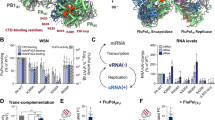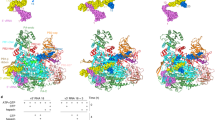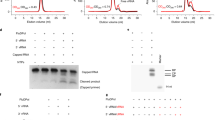Abstract
The influenza virus polymerase, a heterotrimer composed of three subunits, PA, PB1 and PB2, is responsible for replication and transcription of the eight separate segments of the viral RNA genome in the nuclei of infected cells. The polymerase synthesizes viral messenger RNAs using short capped primers derived from cellular transcripts by a unique 'cap-snatching' mechanism1. The PB2 subunit binds the 5′ cap of host pre-mRNAs2,3,4, which are subsequently cleaved after 10–13 nucleotides by the viral endonuclease, hitherto thought to reside in the PB2 (ref. 5) or PB1 (ref. 2) subunits. Here we describe biochemical and structural studies showing that the amino-terminal 209 residues of the PA subunit contain the endonuclease active site. We show that this domain has intrinsic RNA and DNA endonuclease activity that is strongly activated by manganese ions, matching observations reported for the endonuclease activity of the intact trimeric polymerase6,7. Furthermore, this activity is inhibited by 2,4-dioxo-4-phenylbutanoic acid, a known inhibitor of the influenza endonuclease8. The crystal structure of the domain reveals a structural core closely resembling resolvases and type II restriction endonucleases. The active site comprises a histidine and a cluster of three acidic residues, conserved in all influenza viruses, which bind two manganese ions in a configuration similar to other two-metal-dependent endonucleases. Two active site residues have previously been shown to specifically eliminate the polymerase endonuclease activity when mutated9. These results will facilitate the optimisation of endonuclease inhibitors10,11,12 as potential new anti-influenza drugs.
This is a preview of subscription content, access via your institution
Access options
Subscribe to this journal
Receive 51 print issues and online access
$199.00 per year
only $3.90 per issue
Buy this article
- Purchase on Springer Link
- Instant access to full article PDF
Prices may be subject to local taxes which are calculated during checkout




Similar content being viewed by others
References
Plotch, S. J., Bouloy, M., Ulmanen, I. & Krug, R. M. A unique cap(m7GpppXm)-dependent influenza virion endonuclease cleaves capped RNAs to generate the primers that initiate viral RNA transcription. Cell 23, 847–858 (1981)
Li, M. L., Rao, P. & Krug, R. M. The active sites of the influenza cap-dependent endonuclease are on different polymerase subunits. EMBO J. 20, 2078–2086 (2001)
Fechter, P. et al. Two aromatic residues in the PB2 subunit of influenza A RNA polymerase are crucial for cap binding. J. Biol. Chem. 278, 20381–20388 (2003)
Guilligay, D. et al. The structural basis for cap binding by influenza virus polymerase subunit PB2. Nature Struct. Mol. Biol. 15, 500–506 (2008)
Shi, L., Summers, D. F., Peng, Q. & Galarz, J. M. Influenza A virus RNA polymerase subunit PB2 is the endonuclease which cleaves host cell mRNA and functions only as the trimeric enzyme. Virology 208, 38–47 (1995)
Doan, L., Handa, B., Roberts, N. A. & Klumpp, K. Metal ion catalysis of RNA cleavage by the influenza virus endonuclease. Biochemistry 38, 5612–5619 (1999)
Klumpp, K., Doan, L., Roberts, N. A. & Handa, B. RNA and DNA hydrolysis are catalyzed by the influenza virus endonuclease. J. Biol. Chem. 275, 6181–6188 (2000)
Tomassini, J. et al. Inhibition of cap (m7GpppXm)-dependent endonuclease of influenza virus by 4-substituted 2,4-dioxobutanoic acid compounds. Antimicrob. Agents Chemother. 38, 2827–2837 (1994)
Hara, K., Schmidt, F. I., Crow, M. & Brownlee, G. G. Amino acid residues in the N-terminal region of the PA subunit of influenza A virus RNA polymerase play a critical role in protein stability, endonuclease activity, cap binding, and virion RNA promoter binding. J. Virol. 80, 7789–7798 (2006)
Hastings, J. C., Selnick, H., Wolanski, B. & Tomassini, J. E. Anti-influenza virus activities of 4-substituted 2,4-dioxobutanoic acid inhibitors. Antimicrob. Agents Chemother. 40, 1304–1307 (1996)
Tomassini, J. E. et al. A novel antiviral agent which inhibits the endonuclease of influenza viruses. Antimicrob. Agents Chemother. 40, 1189–1193 (1996)
Parkes, K. E. et al. Use of a pharmacophore model to discover a new class of influenza endonuclease inhibitors. J. Med. Chem. 46, 1153–1164 (2003)
Fodor, E. et al. A single amino acid mutation in the PA subunit of the influenza virus RNA polymerase inhibits endonucleolytic cleavage of capped RNAs. J. Virol. 76, 8989–9001 (2002)
Lee, M. T. et al. Definition of the minimal viral components required for the initiation of unprimed RNA synthesis by influenza virus RNA polymerase. Nucleic Acids Res. 30, 429–438 (2002)
Honda, A., Mizumoto, K. & Ishihama, A. Minimum molecular architectures for transcription and replication of the influenza virus. Proc. Natl Acad. Sci. USA 99, 13166–13171 (2002)
He, X. et al. Crystal structure of the polymerase PAC–PB1N complex from an avian influenza H5N1 virus. Nature 454, 1123–1126 (2008)
Obayashi, E. et al. The structural basis for an essential subunit interaction in influenza virus RNA polymerase. Nature 454, 1127–1131 (2008)
Nishino, T., Komori, K., Tsuchiya, D., Ishino, Y. & Morikawa, K. Crystal structure of the archaeal Holliday junction resolvase Hjc and implications for DNA recognition. Structure 9, 197–204 (2001)
Horton, N. C. & Perona, J. J. DNA cleavage by EcoRV endonuclease: two metal ions in three metal ion binding sites. Biochemistry 43, 6841–6857 (2004)
Knizewski, L., Kinch, L. N., Grishin, N. V., Rychlewski, L. & Ginalski, K. Realm of PD-(D/E)XK nuclease superfamily revisited: detection of novel families with modified transitive meta profile searches. BMC Struct. Biol. 7, 40 (2007)
Beese, L. S. & Steitz, T. A. Structural basis for the 3′-5′ exonuclease activity of Escherichia coli DNA polymerase I: a two metal ion mechanism. EMBO J. 10, 25–33 (1991)
Viadiu, H. & Aggarwal, A. K. The role of metals in catalysis by the restriction endonuclease BamHI. Nature Struct. Biol. 5, 910–916 (1998)
Tarendeau, F. et al. Host determinant residue lysine 627 lies on the surface of a discrete, folded domain of influenza virus polymerase PB2 subunit. PLoS Pathog. 4, e1000136 (2008)
Hagen, M., Chung, T. D., Butcher, J. A. & Krystal, M. Recombinant influenza virus polymerase: requirement of both 5′ and 3′ viral ends for endonuclease activity. J. Virol. 68, 1509–1515 (1994)
Rao, P., Yuan, W. & Krug, R. M. Crucial role of CA cleavage sites in the cap-snatching mechanism for initiating viral mRNA synthesis. EMBO J. 22, 1188–1198 (2003)
Gabriel, G. et al. The viral polymerase mediates adaptation of an avian influenza virus to a mammalian host. Proc. Natl Acad. Sci. USA 102, 18590–18595 (2005)
Salomon, R. et al. The polymerase complex genes contribute to the high virulence of the human H5N1 influenza virus isolate A/Vietnam/1203/04. J. Exp. Med. 203, 689–697 (2006)
Ericsson, U. B., Hallberg, B. M., Detitta, G. T., Dekker, N. & Nordlund, P. Thermofluor-based high-throughput stability optimization of proteins for structural studies. Anal. Biochem. 357, 289–298 (2006)
Saito, T., Owen, D. M., Jiang, F., Marcotrigiano, J. & Gale, M. Innate immunity induced by composition-dependent RIG-I recognition of hepatitis C virus RNA. Nature 454, 523–527 (2008)
Baudin, F., Bach, C., Cusack, S. & Ruigrok, R. W. Structure of influenza virus RNP. I. Influenza virus nucleoprotein melts secondary structure in panhandle RNA and exposes the bases to the solvent. EMBO J. 13, 3158–3165 (1994)
Acknowledgements
We thank the ESRF, EMBL and MRC-France for access to synchrotron facilities and the Partnership for Structural Biology for an integrated structural biology environment. The work was partially funded by the EU FLUPOL contract (SP5B-CT-2007-044263) and the ANR FLU INTERPOL contract (ANR-06-MIME-014-02). A.D. has a PhD fellowship from the MENRT. We thank J.-L. Decout for advice about the inhibitor, E. Kowalinski and C. Swale for RNA transcripts, and C. Petosa and J. Perona for a critical reading of the manuscript.
Author Contributions A.D., D.B., T.C. and A.A.M. performed the experiments, D.J.H. and F.B. supervised the search for a soluble fragment of PA, R.W.H.R. and S.C. supervised the biochemical characterization of PA-Nter, and S.C. supervised the crystallography. S.C. wrote the paper with the help of A.D., D.B., T.C. and R.W.H.R.
Author information
Authors and Affiliations
Corresponding author
Ethics declarations
Competing interests
Patent application in progress.
Supplementary information
Supplementary Information
This file contains Supplementary Figures 1-4 with Legends, Supplementary Table 1, Supplementary Methods and Supplementary References. (PDF 1232 kb)
Rights and permissions
About this article
Cite this article
Dias, A., Bouvier, D., Crépin, T. et al. The cap-snatching endonuclease of influenza virus polymerase resides in the PA subunit. Nature 458, 914–918 (2009). https://doi.org/10.1038/nature07745
Received:
Accepted:
Published:
Issue Date:
DOI: https://doi.org/10.1038/nature07745
This article is cited by
-
The impact of PA/I38 substitutions and PA polymorphisms on the susceptibility of zoonotic influenza A viruses to baloxavir
Archives of Virology (2024)
-
The ubiquitination landscape of the influenza A virus polymerase
Nature Communications (2023)
-
Cut site preference allows influenza A virus PA-X to discriminate between host and viral mRNAs
Nature Microbiology (2023)
-
Synthesis, anti-inflammatory activity, and acute toxicity of the substituted 2-[2-(4-nitrobenzoyl)hydrazono]-4-oxobutanoates
Russian Chemical Bulletin (2023)
-
Synthesis and anti-inflammatory activity of N-arylamides of 4-aryl- and 4-(thiophen-2-yl)-2-[2-(furan-2-carbonyl)hydrazono]-4-oxobutanoic acids
Russian Chemical Bulletin (2023)
Comments
By submitting a comment you agree to abide by our Terms and Community Guidelines. If you find something abusive or that does not comply with our terms or guidelines please flag it as inappropriate.



